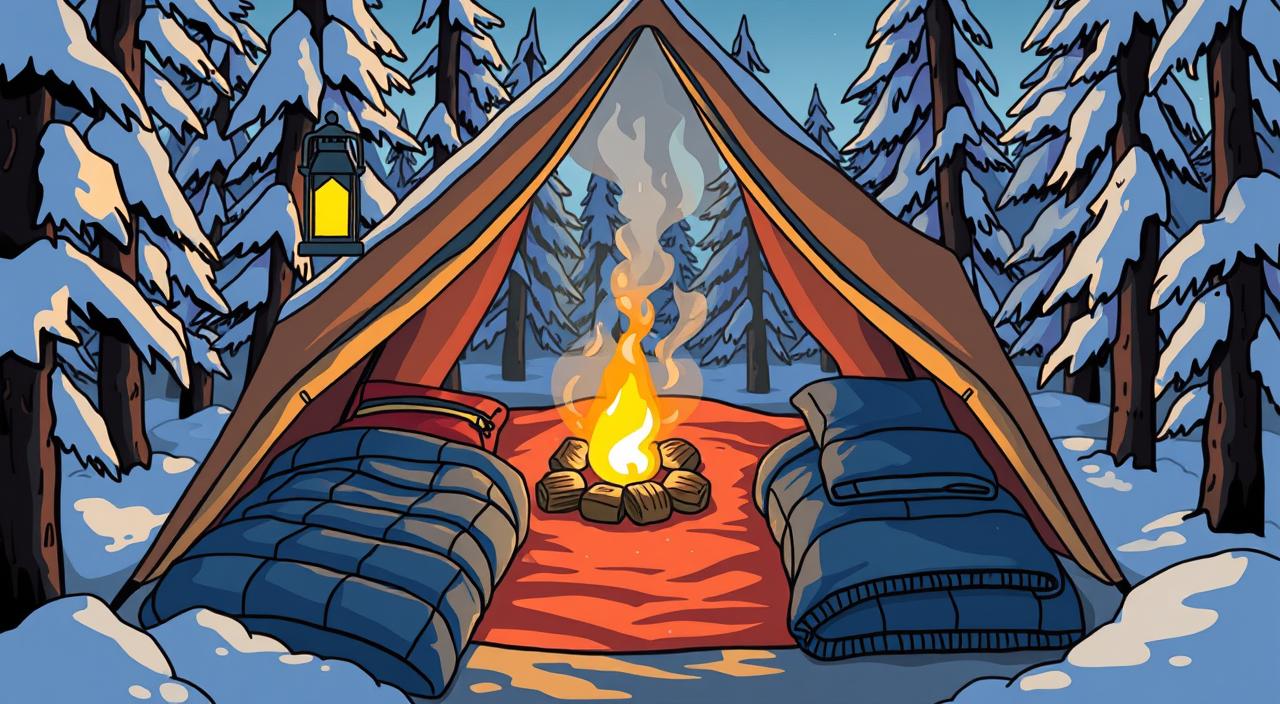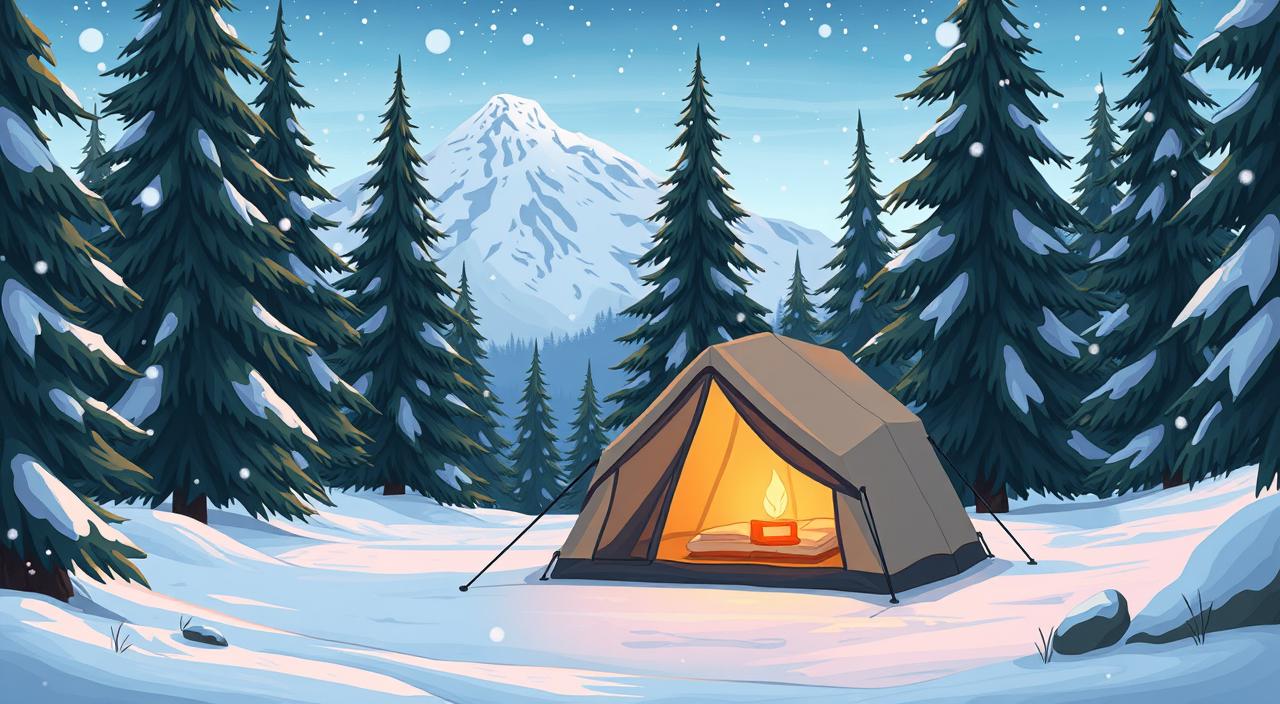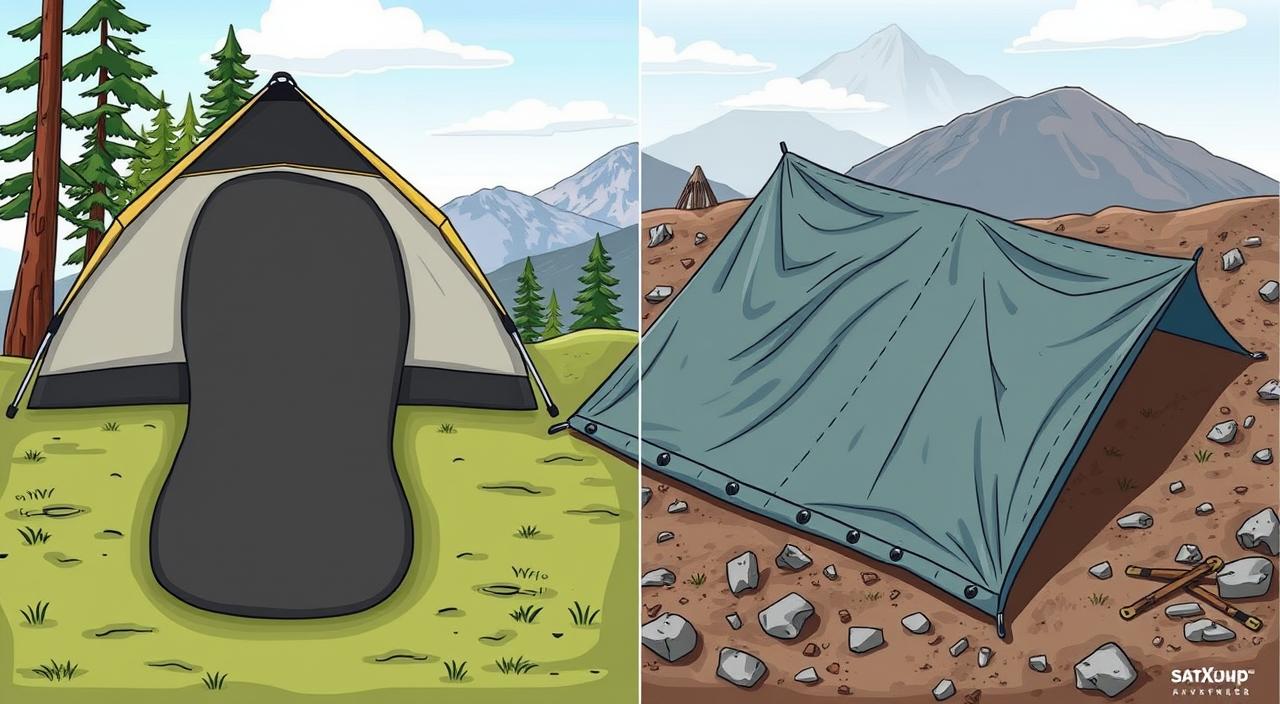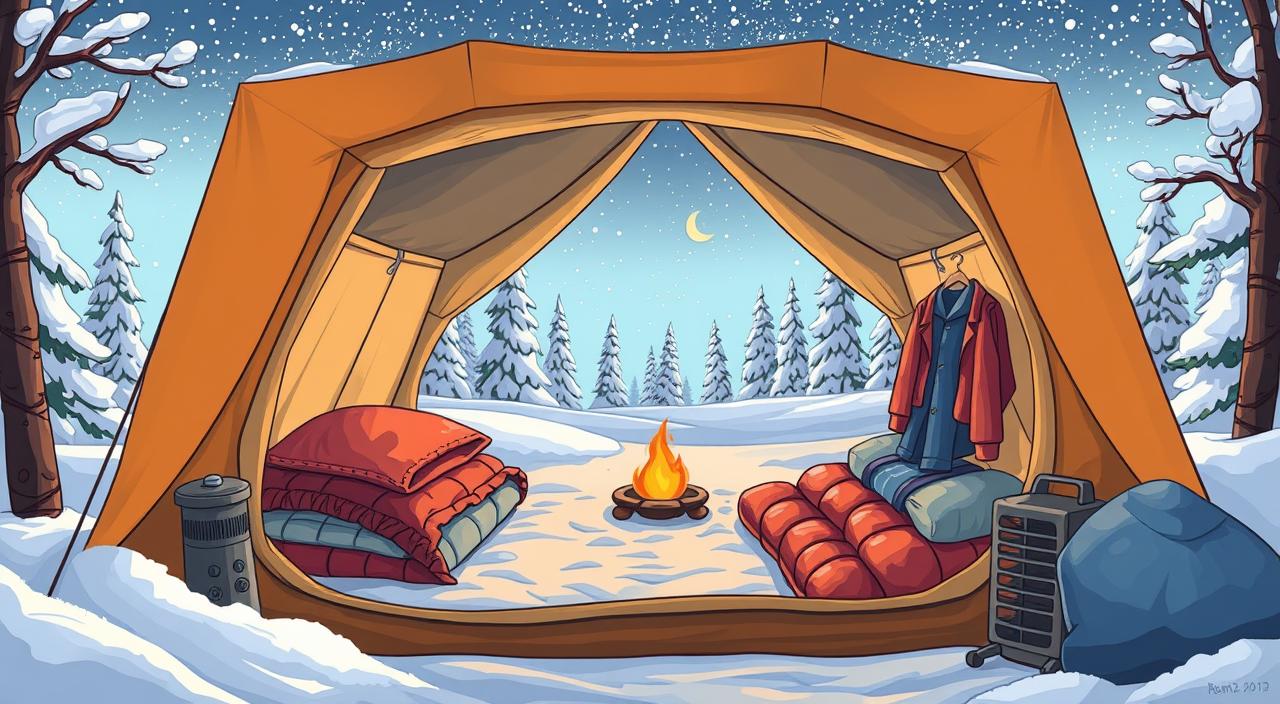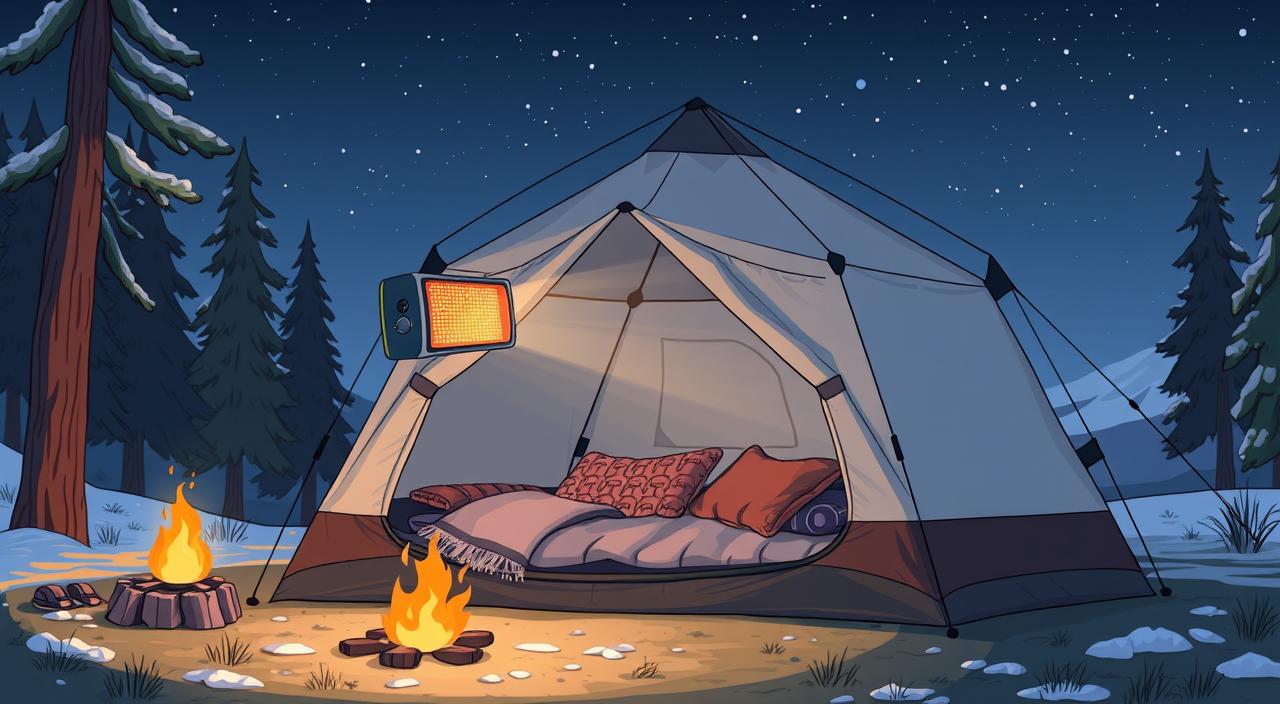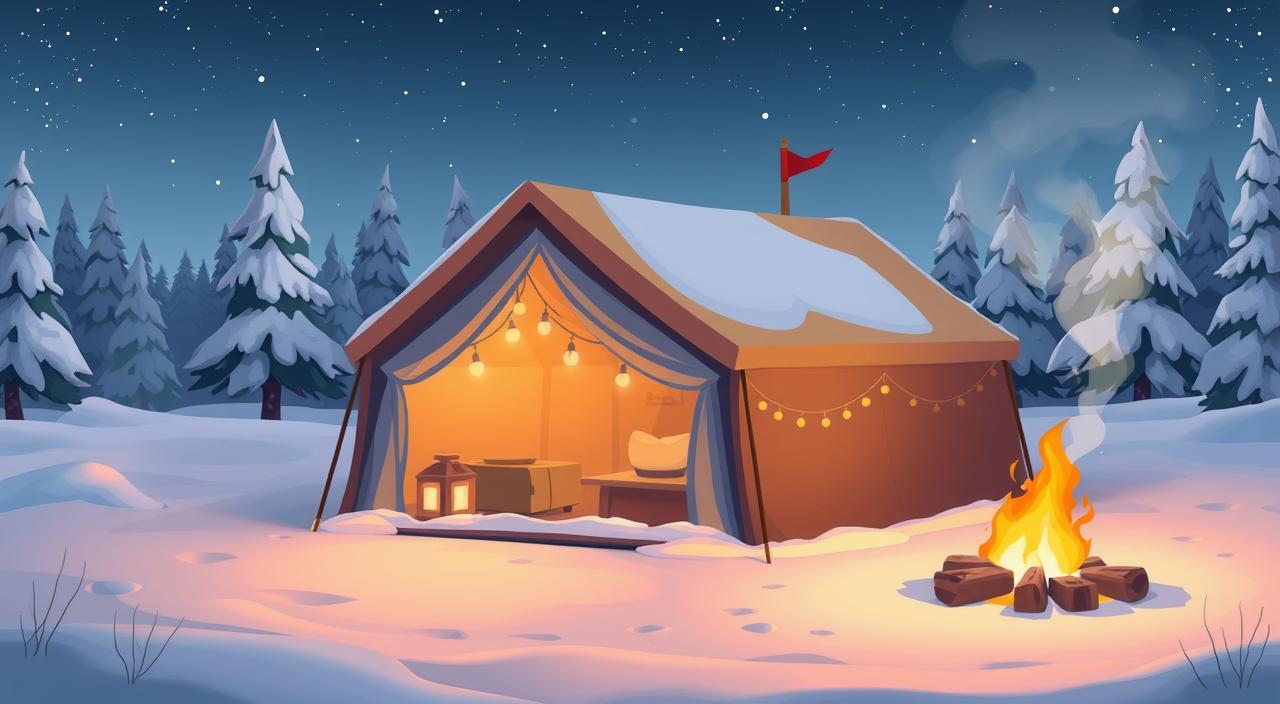
Disclaimer: This post may contain affiliate links. As an Amazon Associate, we earn from qualifying purchases.
Ever thought about enjoying winter’s calm beauty while staying warm in your tent? Tent camping in cold weather is an adventure that brings peace and challenges. With Grand Canyon temperatures below freezing, getting ready right is key to staying safe. This guide will give you winter camping tips for choosing the right gear, staying safe, and keeping warm on your cold-weather trip.
Learning about cold-weather camping lets you enjoy the cold, not just survive it. From warm sleeping bags to keeping your body cozy, every little thing counts when you’re in your tent. Are you ready to make your camping trips unforgettable this winter?
Key Takeaways
- Choosing sleeping bags rated for temperatures significantly lower than the expected nighttime lows ensures comfort.
- Using insulated sleeping pads can prevent heat loss from the ground.
- Layering appropriately can maintain body warmth and manage moisture.
- Calorie-dense snacks and hydration are crucial for energy levels when camping in cold weather.
- Always keep a spare set of clothing dry and accessible to avoid freezing temperatures.
Essential Gear for Cold-Weather Camping
Getting ready for cold-weather camping means knowing what gear you need for comfort and safety. The right equipment is key when it gets cold. Look for quality and make sure it fits the conditions you’ll face.
Sleeping Bags with Appropriate Temperature Ratings
Choose sleeping bags made for the cold. High-quality bags like the Feathered Friends Snowbunting EX 0 offer great warmth. They should be rated at least 10°F lower than the coldest expected temperature. For extra warmth, add a sleeping bag liner. It can increase your temperature rating by 5 to 25°F, keeping you warm all night.
Insulated Sleeping Pads to Minimize Heat Loss
Insulated sleeping pads are vital for keeping warm at night. The Therm-a-Rest NeoAir XTherm NXT is a top choice for its high R-value, great for freezing temperatures. If inflatable pads aren’t available, closed-cell foam pads are a reliable backup. A good night’s sleep is crucial, so don’t forget a camp pillow for extra comfort.
Weather-Resistant Tents for Extreme Conditions
Choosing the right tent is crucial for cold-weather camping. Go for tents like the Mountain Hardwear Trango 2, built for extreme weather with strong poles and thick fabric. If you expect heavy snow and strong winds, a four-season tent is best. A three-season tent is okay if you stay below the tree line and avoid storms.
| Gear Type | Recommended Model | Price | Notes |
|---|---|---|---|
| Sleeping Bag | Feathered Friends Snowbunting EX 0 | $719 | Best for extreme cold with high warmth-to-weight ratio. |
| Insulated Sleeping Pad | Therm-a-Rest NeoAir XTherm NXT | $240 | High R-value, ideal for below-freezing temperatures. |
| Weather-Resistant Tent | Mountain Hardwear Trango 2 | $900 | Durable design with great livability for winter conditions. |
Before You Go: Check Weather Conditions and Hazards
Before you start a cold-weather camping trip, make sure to check the weather. Knowing the temperature changes helps plan your trip better. Weather can change fast, making a trip dangerous. Always look for the latest info from ranger stations.
Knowing about hazards in the area is key to staying safe while camping in winter. Think about the risks of avalanches, ice, and extreme wind chill. This knowledge helps you plan and avoid dangers. Keep an eye on storm warnings and adjust your gear for sudden weather changes.
Think about bringing a portable weather station. These gadgets give you updates and alerts on weather changes. Having this info helps you make smart choices and lowers the risks of winter camping.
In summary, getting ready for your trip by checking the weather is crucial for safety. Take time to look at the environment, get the right gear, and stay alert. Enjoy the beauty of winter while staying safe.
| Weather Condition | Recommended Action |
|---|---|
| Heavy Snowfall | Postpone or cancel trip. Check for avalanche warnings. |
| Subzero Temperatures | Use specialized winter gear. Limit exposure time outside. |
| Strong Winds | Select a sheltered campsite. Reinforce tent stability. |
| Rain with Freezing Temperatures | Choose waterproof gear. Prepare for possible icy conditions. |
| Mountains or Challenging Terrain | Assess trails carefully. Follow signage and warnings. |
Tent Camping in Cold Weather: Setting Up for Success
When camping in the cold, pay close attention to where you set up. Look for a spot that’s dry, flat, and away from trails and water. It should also have some natural wind protection, like big rocks or trees, and face east for morning sun.
Getting ready is key to a good tent setup. Clear the snow and make a level spot for your tent. Use your tools or boots to pack down the snow. Make sure your tent’s narrow side is into the wind for the best protection.
For snowy areas, tie your tent down well. Use stakes, guy lines, or trekking poles for extra stability. If it’s your first time, wait for a sunny day to set up. Experts suggest a three-season tent if it’s not too windy and there’s no heavy snow.
Choosing the Right Tent Location
Choosing the right spot for your tent makes camping better. Keep it at least 200 feet from trees to avoid dangers like tree wells or falling branches. Here are some top picks for tents in the snow:
| Tent Model | Best Features |
|---|---|
| Big Agnes Copper Spur 3 | Freestanding, lightweight, spacious |
| MSR Hubba Hubba 2 | Durable with good ventilation |
| Big Agnes Crag Lake 2 Tent | Weather-resistant, roomy design |
| REI Co-op Half Dome SL 3+ | Easy setup, versatile in conditions |
| NEMO Dagger OSMO 3P | Waterproof, high-quality materials |
| Sea to Summit Telos TR2 Plus | Spacious, excellent ventilation |
| MSR Access 3 | Ideal for high winds and snow |
| Mountain Hardwear Trango 2 | Stable in extreme conditions |
| The North Face 3 FUTURELIGHT | Advanced weather protection |
| MSR Remote 2 | Designed for harsh environments |
Setting up your tent right makes camping in the cold fun. Don’t forget a satellite phone for emergencies. With the right gear and planning, winter camping can be amazing.
Layering for Cold Weather Camping
Layering your clothes right is key to staying warm and safe when camping in the cold. It’s not just about adding more clothes. It’s about keeping warm, avoiding overheating, blocking wind, and staying dry. Knowing what you need in the Pacific Northwest’s cold weather helps you pick the right clothes.
Choosing the Right Base Layers
Begin with a top-notch base layer from polyester, nylon, silk, or Merino wool. These materials pull moisture away from your skin, keeping you dry and warm. Cotton is a bad choice because it holds in humidity and can make you feel cold and clammy.
Choosing the right base layer is crucial for staying warm while camping in the cold. It should match the temperature and how active you plan to be. For example, hiking pants with a thin thermal layer are great for cold weather below 25º F.
Avoiding Cotton: The Best Fabric Choices
Stay away from cotton because it holds moisture, making you colder. Instead, go for synthetic or natural fibers like wool. These keep you warm without being too heavy.
Insulated gloves or mittens will keep your hands warm. Flannel-lined jeans or insulated overalls will keep your legs warm. And don’t forget warm wool socks for your feet. These choices help you stay warm and dry on your camping trips.
Staying Warm in Your Tent
When camping in cold weather, keeping warm inside your tent is key. Using good insulation makes a big difference in your comfort at night. Here are some tips to keep your camping trip cozy, even when it gets cold.
Effective Insulation Techniques
Insulation is crucial for staying warm in a tent. Closed-cell foam pads under your sleeping bag help keep heat from escaping to the ground. Choose sleeping pads with a high R-value, over 4, for temperatures below 15°F. This layer keeps your body heat in and protects you from the cold ground.
Using a Hot Water Bottle
A hot water bottle can be a great source of warmth. Fill an uninsulated bottle with warm water and put it near your core, like your stomach or feet. This method provides hours of warmth, making a big difference in how warm you feel while sleeping.
Managing Moisture in Your Tent
Managing moisture is important when camping in the cold. Watch out for condensation inside your tent, as it can lower insulation. Don’t breathe into your sleeping bag and change into dry clothes before bed. Open the tent flap or window a bit for better ventilation, keeping the air dry while you sleep.
Winter Camping Safety Tips
Winter camping safety is key for a fun outdoor trip. Knowing how to spot hypothermia signs can save lives. It helps you act fast to keep you and your friends safe.
Recognizing the Signs of Hypothermia
Hypothermia can happen even when it’s not freezing cold. It’s important to spot its signs early. Look out for these symptoms:
- Intense shivering
- Slow, shallow breathing
- Confusion or difficulty thinking clearly
- Fatigue or drowsiness
- Weak pulse
If you see these signs, act fast. Move to a warmer spot, take off wet clothes, and use blankets to warm up. Always be careful when camping in the winter.
Establishing a Safety Protocol
Having a safety plan makes winter camping safer. Tell someone you trust your trip details, like where you’re going and how long you’ll be gone. Check in regularly to stay safe. Think about bringing a satellite device for emergencies.
Make sure everyone knows the hypothermia signs and safety steps. Working together keeps everyone safe and ready for winter challenges.
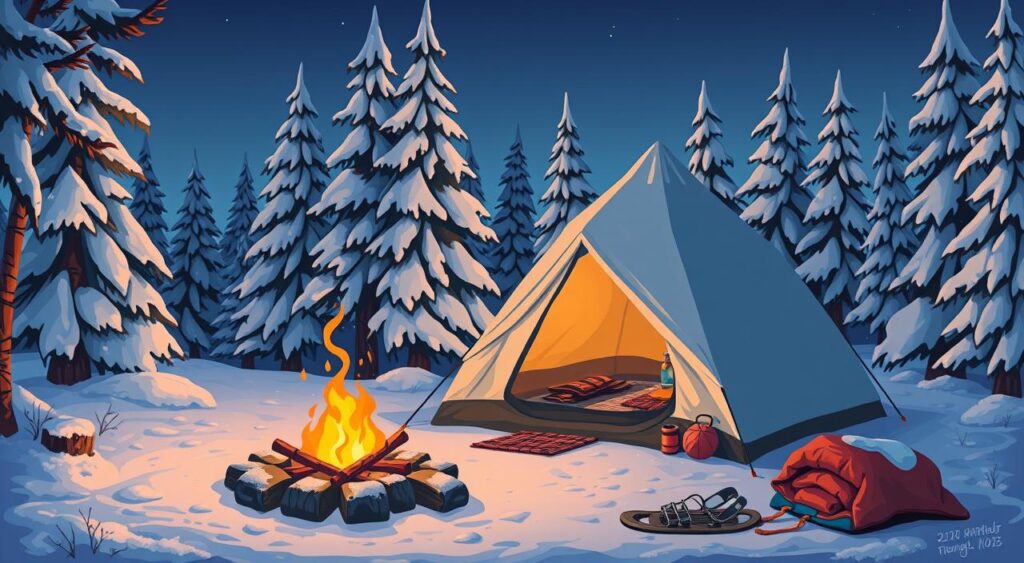
Food and Hydration: Keeping Energy Levels Up
When you go camping in the cold, eating right and drinking enough water is key to staying energized. Choose snacks and meals packed with nutrients to fuel your activities and keep you warm.
Importance of Nutrient-Dense Snacks
While camping in winter, eating high-calorie foods can help refill your energy. Go for snacks loaded with proteins and healthy fats, like:
- Nuts and seeds
- Dried fruits
- Energy bars made from natural ingredients
- Jerky or other protein-rich options
These snacks give you long-lasting energy and help with your cold weather camping diet. Eating three hot meals a day can also boost your warmth and energy outdoors.
Hydration Tips: How to Stay Hydrated in Cold Weather
Even if you don’t feel thirsty, staying hydrated is crucial in the cold. Here are some tips:
- Carry a thermos with warm drinks like herbal tea or hot chocolate.
- Add soups or stews to your meals for hydration and warmth.
- Check your hydration by looking for clear, pale urine.
Looking after your hydration is key to avoiding fatigue and making your camping trip better.
Managing Moisture on Cold Camping Trips
When you go camping in the cold, managing moisture is key for a good trip. Keeping moisture under control can help avoid condensation. This keeps you and your gear dry and comfortable. Learning how to manage moisture makes your cold camping trip better.
Condensation Prevention Techniques
To fight condensation, try simple but effective methods. Use a footprint or ground tarp under your tent for insulation and moisture protection. Make sure your tent has good airflow to keep it warm but not too damp. Adding roof vents and outside air intakes helps with ventilation.
This keeps moisture from building up in your sleeping area. Good ventilation can cut down on condensation and keep things dry.
Moisture Absorbers for Your Tent
Using moisture absorbers in your tent is a great way to control humidity. Dri-Z-Air dehumidifiers are good for cold weather and reduce dampness. For tougher moisture issues, consider a backpackable wood stove to dry your gear and keep you warm.
If you’re camping for several days, make sure to dry your sleeping bag often. Hang it in the cold, dry air to help it dry out. Dark-colored sleeping bags dry faster in sunlight. Try not to breathe into your sleeping bag to prevent moisture buildup.
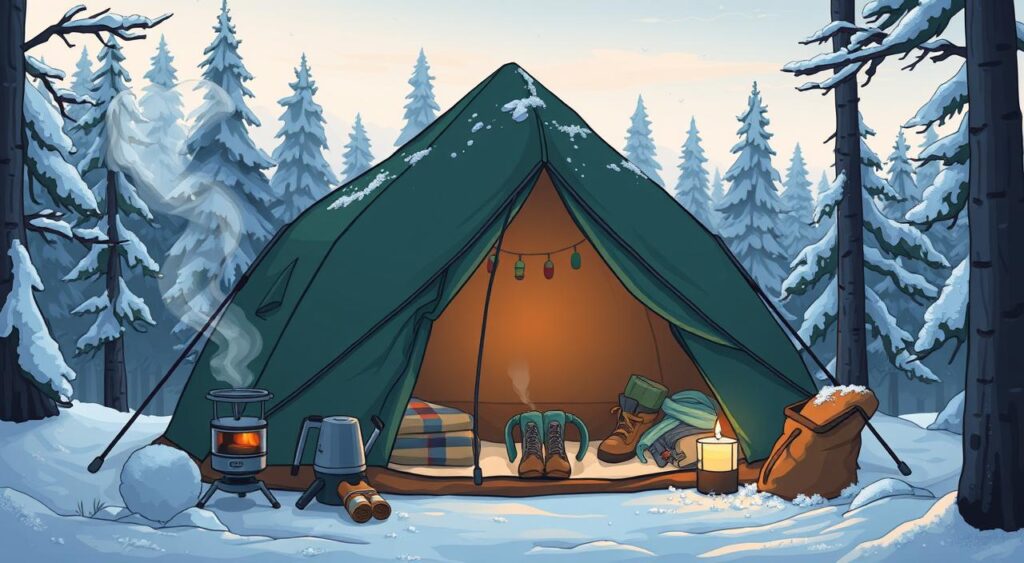
These tips can make your cold camping trip better. Share your experiences to improve your moisture control methods.
Heating Solutions for Your Camping Setup
When it gets cold, having good heating is key to staying warm while camping. Using tent heaters can make your tent cozy, especially after being outside all day. You can also try using heated rocks for a natural warmth. Knowing how to safely use these heaters can make your camping trip better.
Using Tent Heaters Safely
Portable tent heaters like the Mr. Heater Little Buddy are great for staying warm. This heater costs about $105 and gives you five hours of heat with a one-pound propane bottle. For bigger tents or longer use, the Mr. Heater Buddy propane model is a good choice at $130, with a strong 9,000 BTU output. Always use tent heaters safely by ensuring good airflow and watching them closely to avoid danger.
Alternative Heating Methods: Heated Rocks and More
Heated rocks are a classic way to warm up your tent naturally. Just warm the rocks by the fire and put them in your tent. They’ll keep releasing heat all night, making it cozy to sleep. No matter what heating you choose, keep your tent well-ventilated for safety. Also, make sure to keep water jugs upside down at night to stop them from freezing and have water ready for the morning.
| Heating Method | Cost | Heat Duration | Key Features |
|---|---|---|---|
| Mr. Heater Little Buddy | $105 | ~5 hours | Compact, portable, safety features |
| Mr. Heater Buddy | $130 | Variable (up to 9,000 BTU) | Powerful, reliable, suitable for larger tents |
| Seek Outside Redcliff Hot Tent | $1,355 | Dependent on installation | Spacious for multiple users, high-quality materials |
| Quality Portable Diesel Heaters | Starting at $1,700 | Long-lasting, powerful | Lightweight, efficient for cold weather |
| SnowTrekker Basecamp Canvas Tent | $2,000 | Variable (depends on stove usage) | Durable, compatible with wood-burning stove ($300 extra) |
Choosing the Right Cold Weather Camping Gear
Choosing the right gear for cold weather camping can make your trip better. It’s important to pick items that keep you warm and comfy at night. High-quality sleeping bags with the right temperature ratings are key for winter camping.
Invest in High-Quality Winter Sleeping Bags
When camping in the cold, a good sleeping bag is crucial for your comfort. Make sure to choose bags with temperature ratings that match the weather you’ll face. Brands like Big Agnes and Nemo offer great sleeping bags for cold weather.
Also, pay attention to the R-value of your sleeping pad. It should work well with your sleeping bag’s insulation.
Other Gear Essentials: Hats, Gloves, and More
Other important gear for cold weather includes items that keep you warm and protect you from the cold. Make sure to bring:
- Warm hats that fit snugly to retain heat
- Insulated gloves for hand warmth
- Moisture-wicking base layers for added insulation
- Scarves and face masks to shield against wind chill
These items are crucial for staying warm at night. With high-quality sleeping bags and other gear, your camping trips will be much more fun.
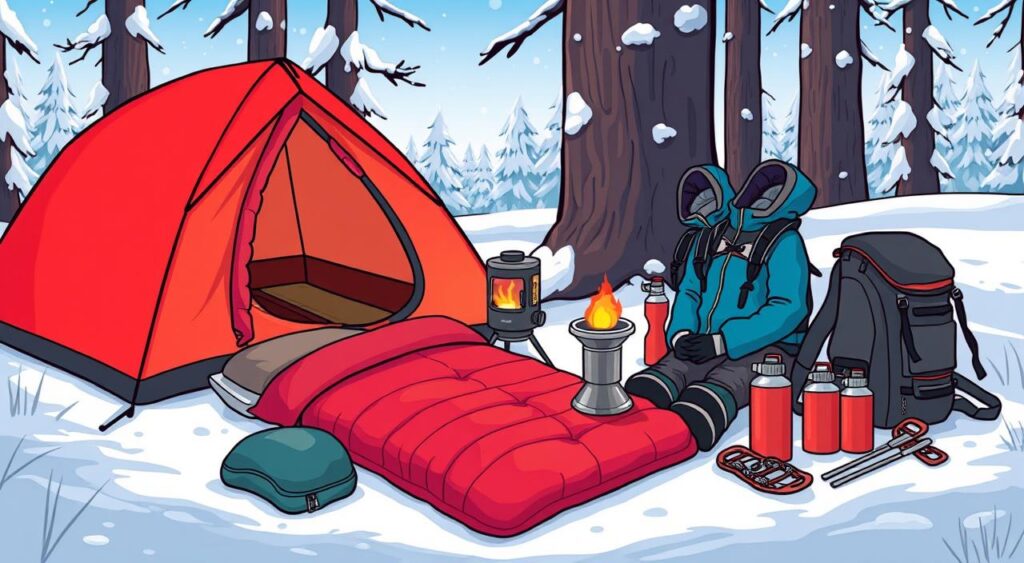
Creating a Cozy Atmosphere Inside Your Tent
Making your tent cozy can make winter camping much better. The right setup can turn a cold night into a warm, restful one. Start by adding extra blankets inside your tent. These not only keep you warm but also make the tent feel snug. You can put them over your sleeping bag or around the tent for extra comfort.
Using Blankets for Additional Warmth
For a cozy tent, bring different blankets. Fleece or wool blankets are great for insulation. Piling these on your sleeping area adds an extra layer against the cold. Keep some extra for layering on really cold nights. This helps keep you warm and comfortable all night.
Organizing Your Tent Space for Comfort
It’s key to organize your tent for comfort and ease. Use tools like hanging closet organizers or S-hooks to keep things within reach. A tidy tent makes it easier to move around, even in the dark and cold. Keep important items like your light and shoes near the entrance for quick access. These tips help you stay cozy and find what you need easily.
| Organizing Strategies | Benefits |
|---|---|
| Hanging closet organizers | Keeps small items off the ground, reducing clutter |
| S-hooks for gear | Allows for quick access to frequently used items |
| Stuff sacks for clothes | Helps insulate gear and saves space |
| Reflective blankets | Blocks excess light, maintaining a tranquil environment |
How to Manage Tent Camping on High-Wind Nights
Tent camping in high winds can be tough, even for experts. It’s key to prepare your tent for wind to stay safe and comfy. This means setting up your tent right and finding ways to sleep well despite the wind.
Adjusting Tent Setup for Wind Resistance
When winds get strong, adjust your tent setup. Here are some important tips:
- Position your tent: Make sure the tent’s narrow side faces the wind to reduce wind resistance.
- Secure stakes: Use stakes made for wind and add extra guy lines for better stability.
- Choose a sheltered location: Look for spots with trees or hills to block the wind.
Sleep Shifts in High Winds
Switching off during the night is smart when camping in high winds. One person can check on the tent while the other rests. This keeps the tent safe and reduces worries about damage or moving in the night.
| Strategy | Description |
|---|---|
| Orientation | Align the tent’s narrowest side into the wind |
| Staking | Use heavy-duty stakes and extra guy lines |
| Shelter | Set up near natural barriers for wind protection |
| Sleep Shifts | Alternate checking the tent to stay warm |
With these tips, you can enjoy camping even with high winds. Good planning helps ensure a safe and fun outdoor adventure.
Conclusion
Tent camping in cold weather is a thrilling challenge that brings unique and rewarding experiences. With the right winter camping prep, you can stay comfortable and avoid the dangers of low temperatures. A key item is a good winter sleeping bag, like the Kelty Cosmic 20 Down, which keeps you warm and insulated.
It’s also vital to know how temperature changes affect your camp. A clear night can make your tent colder, but a well-insulated tent helps keep you warm. Wearing layers and using insulation right makes your camping trip more enjoyable.
This article has given you the tips you need for winter camping. From picking the right tent to keeping warm, you’re set for your outdoor adventure. For more tips on cold-weather camping, check out this link for more info.




















